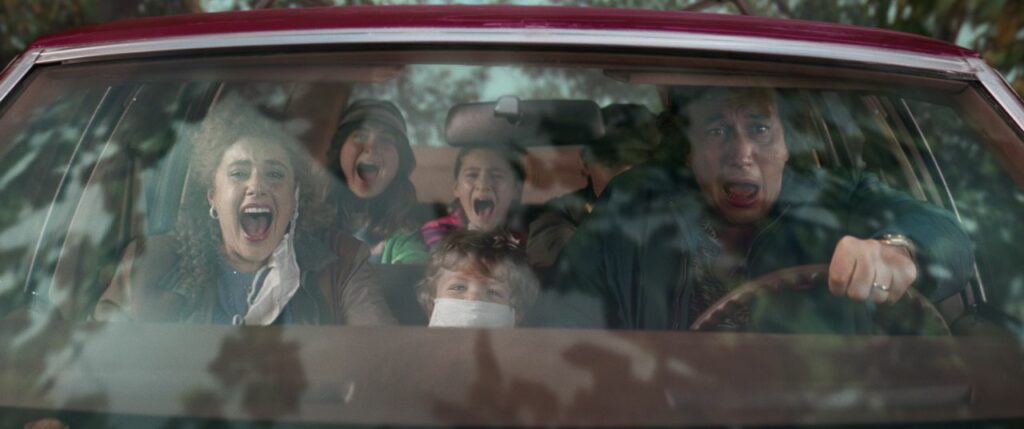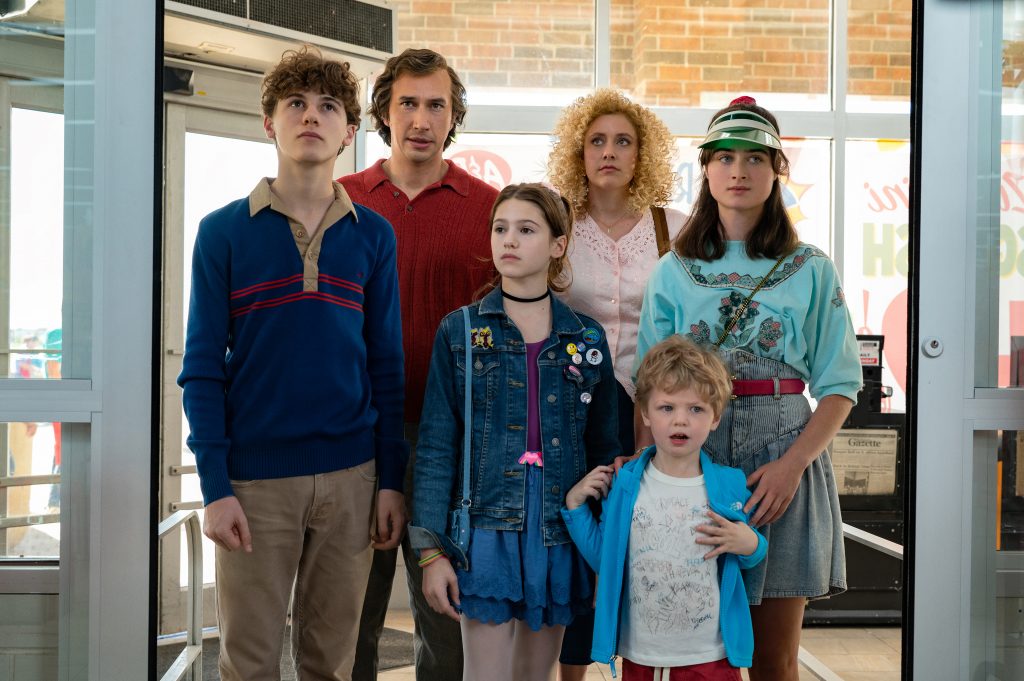
WHITE NOISE – (Front L-R) Greta Gerwig as Babette, Dean Moore/Henry Moore as Wilder and Adam Driver as Jack (Back L-R) Raffey Cassidy as Denise, May Nivola as Steffie and Sam Nivola as Heinrich in White Noise. Netflix
SOURCE: Cleveland.com | Joey Morona
November 30, 2022
CLEVELAND, Ohio — Early in “White Noise,” the filmed-in-Northeast Ohio movie opening at the Cedar Lee Theatre on Friday and streaming on Netflix starting December 30, parents Jack (Adam Driver) and Babette (Greta Gerwig) argue with their kids Denise (Raffey Cassidy), Heinrich (Sam Nivola) and Steffi (May Nivola) over whether the toxic, black smoke headed for their town is a “feathery plume” or a “billowing cloud.”
In a typical disaster movie, the protagonists would be getting the hell out of dodge instead of debating semantics. But while writer-director Noah Baumbach’s adaptation of Don DeLillo’s 1985 novel has all the trappings of a disaster film, it turns out to be much more: a marriage story, a professor movie, even a neo-noir comedy.
These characters aren’t simply trying to make it out of the so-called “airborne toxic event” alive and back home to their cupboards of cereal. In fact, the “disaster” in the disaster movie isn’t even their biggest obstacle. It’s trying to find hope and happiness amid all the “white noise” in the world: excessive consumerism, looming environmental catastrophe, the breakdown of religion, the spread of misinformation, the constant fear of death, etc.,
So, yeah, it’s a lot.
“White Noise” is full of big ideas. In less capable hands, they might come off as overhanded and didactic. But Baumbach’s flair for dialogue (nominated twice for an Oscar for best original screenplay) is like a spoonful of sugar helping the medicine go down. There is an inexplicable beauty in his script. Mundane discussions — and there are quite a few of them in this film — sound like poetry. I could listen to Jack and Babette argue over the language of trashy romance novels or Don Cheadle’s Professor Murray Siskind lecture about the evolution of car crash scenes in Hollywood movies all day.
But I suspect you wouldn’t want to watch that movie.
It’s 1985 and this is the story of Jack Gladney, an enigma of an academic who teaches Hitler studies at the local college but doesn’t speak German. He lives in a state of constant dread and insecurity. Babette, who teaches fitness classes and reads for the elderly, conceals her anxiety under her big, glorious head of hair, secretly popping off-market pills to help her cope. Each of their kids (Wilder, played by twins Dean and Henry Moore, is the fourth) is better equipped to handle the pending crisis.

Sam Nivola as Heinrich, Adam Driver as Jack, May Nivola as Steffie, Greta Gerwig as Babette, Dean Moore/Henry Moore as Wilder and Raffey Cassidy as Denise in the Netflix release “White Noise.”Wilson Webb/Netflix
That crisis, err, the airborne toxic event, is the result of a spectacular collision between a train and a tanker trunk. Suddenly, their delicate family dynamic is thrown into chaos and a seemingly endless series of traffic jams and overcrowded evacuation centers. Jack, despite his intellectual bona fides, is totally inept at keeping it together and only adds to the mass hysteria surrounding them. Think if “The Day After Tomorrow” was a comedy.
But cheating death, which they do, just makes matters worse. When Jack learns he’s been exposed to the toxins and probably has only “15 to 30 years” to live, as a disaster simulation intern tells him, he treats it as a death sentence despite all of the other, more immediate health ailments he faces. Babette, meanwhile, becomes even more distant and lost in those pills until Jack confronts her to reveal the truth because, as he puts it to her, “the point of Babette is that she reveals and confides.”
From there, the film goes off the rails in a noir-ish third act as both Jack and Babette are sent over the edge and driven to acts of desperation. The tonal shift is the kind of WTF moment that might make you give up on a movie. But not one that features Driver, pot-bellied and disheveled, delivering one of his best performances as the perpetually exasperated Jack; or Gerwig, more known for her directing and screenwriting efforts than her acting but a revelation here as the quietly, but deeply traumatized Babette.
For the hundreds of industry professionals from the region and thousands of local background actors who worked on the film, the best performance perhaps comes courtesy of Northeast Ohio itself. Baumbach’s 1980s utopia looks stunning in all of its 35mm glory as he, director of photography Lol Crawley and production designer Jess Gonchor transformed Wellington in Lorain County into the idyllic college town of Blacksmith and Downtown Cleveland into its rustbelt neighbor of Iron City. You might have to look closely to see it, but when you know, you know.
Earlier this year, I was watching the closing night film of the Cleveland International Film Festival and, at the end of it, a woman in front of me stood up and said to her companion, “I liked it, I just don’t know how to articulate it.” I had the same reaction when someone asked me on my way out of the theater what I thought of “White Noise.” I have a feeling others will, too.
That’s because Baumbach has made a bold, genre-busting film that has plenty to say and says it in an inventive way that is equally brilliant and frustrating. The ending, for instance, might be a little bit too Hollywood for some tastes. Still, no matter what you make of its sometimes meandering plot or somewhat muddled message, you can’t help but be charmed by the film’s undeniably quirky spirit.
It just might make you want to dance the “New Body Rhumba” in a grocery store.